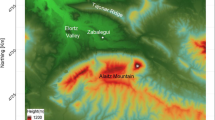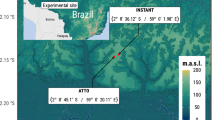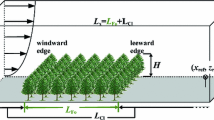Abstract
Based on measurements at Sodankylä Meteorological Observatory the regional (aggregated) momentum and sensible heat fluxes are estimated for two days over a site in Finnish Lapland during late winter. The forest covers 49% of the area. The study shows that the forest dominates and controls the regional fluxes of momentum and sensible heat in different ways. The regional momentum flux is found to be 10–20% smaller than the measured momentum flux over the forest, and the regional sensible heat flux is estimated to be 30–50% of the values measured over a coniferous forest.
The regional momentum flux is determined in two ways, both based on blending height theory. One is a parameterised method, the other represents a numerical solution of an aggregation model. The regional sensible heat flux is determined from the theory of mixed-layer growth. At near neutral conditions the regional momentum flux can be determined independently of the regional sensible heat flux. At unstable conditions the two models become coupled.
The information that is needed by the parameterised blending height method and by the mixed-layer evolution method in order to derive the regional fluxes of momentum and sensible heat can be obtained from radiosonde profiles of wind speed and temperature.
Similar content being viewed by others
References
Batchvarova, E. andGryning, S.-E.: 1991, ‘Applied Model for the Growth of the Daytime Mixed Layer’ Boundary-Layer Meteorol. 56, 261-274.
Batchvarova, E. andGryning, S.-E.: 1994, ‘An Applied Model for the Height of the Daytime Mixed Layer and the Entrainment Zone’ Boundary-Layer Meteorol. 71, 311-323.
Batchvarova, E.,Gryning, S.-E., andde Bruin, H. A. R.: 2001, ‘Parameterisation of Fluxes over a Sparse Boreal Forest at High Latitude’ in S.-E. Gryning andF. Schiermeier (eds.), Air Pollution Modeling and its Application, Vol. XIV, Kluwer Academic Publishers/Plenum Publishers, New York, pp. 427-435.
Beyrich, F.: 2000, ‘What Can We Learn from LIFASS with Regard to the Modelling of Surface Fluxes’ in BALTEX Workshop, Abisco, Sweden, 20-21 June 1999, International BALTEX Secretariat Publication series No. 17, GKSS Research Center, Max Planck Strasse, D-21502 Geestacht, Germany, pp. 49-54.
Bradley, E. F.: 1968, ‘A Micrometeorological Study of Velocity Profiles and Surface Drag in the Region Modified by a Change in Surface Roughness’ Quart. J. Roy. Meteorol. Soc. 94, 361-378.
EEA: 1992, CORINE Land Cover, A European Community Project, European Environmental Agency, Copenhagen, Denmark (dataset on CD).
Gottschalk, L.,Batchvarova, E.,Gryning, S.-E.,Lindroth, A.,Melas, D.,Motovilov, Y.,Fresh, M.,Heikinheimo, M.,Samuelsson, P.,Grelle, A., andPersson, T.: 1999, ‘Scale Aggregation-Comparison of Flux Estimates from NOPEX’ Agric. For. Meteorol. 98-99, 103-119.
Grant, A. L. M. andMason, P. J.: 1990, ‘Observations of Boundary-Layer Structure over Complex Terrain’ Quart. J. Roy. Meteorol. Soc. 116, 159-186
Gryning, S.-E. andBatchvarova, E.: 1994, ‘Parametrization of the Depth of the Entrainment Zone above the Daytime Mixed Layer’ Quart. J. Roy. Meteorol. Soc. 120, 47-58.
Gryning, S.-E. andBatchvarova, E.: 1999, ‘Regional Heat Flux over the NOPEX Area Estimated from the Evolution of the Mixed Layer’ Agric. For. Meteorol. 98-99, 159-167.
Gryning, S. E.,Batchvarova, E. andde Bruin, H. A. R.: 2001, ‘Energy Balance of a Sparse Coniferous High-Latitude Forest under Winter Conditions’ Boundary-Layer Meteorol. 99, 465-488.
Halldin, S. andGryning, S.-E.: 1999, ‘Boreal Forests and Climate’ Agric. For. Meteorol. 98-99, 1-4.
Harding, R.,Gryning, S.-E.,Halldin, S., andLloyd, C.: 2001, ‘Progress in the Understanding of Land/Atmosphere Exchange at High Latitudes’ Theor. Appl. Climatol., in press.
Hasager, C. B. andJensen, N. O.: 1999, ‘Surface-Flux Aggregation in Heterogeneous Terrain’ Quart. J. Roy. Meteorol. Soc. 125, 2075-2102.
Hasager, C. B. andJensen, N. O.: 2001, ‘Scaling-Up Evapotranspiration from Field to Regional Scale Based on Optical Remote Sensing Scenes’ in IAHS Red Book, Wallingford, U.K., in press.
Jaatinen, J.: 2000, Private communication, Development manager, Vaisala Oyj, PB. O. Box 26, FIN-00421 Helsinki, Finland, e-mail: juhana.jaatinen@vaisala.com
Joffre, S. M.,Kangas, M.,Heikinheimo, M., andKitaigorodski, S. A.: 2001, ‘Variability of the Stable and Unstable Atmospheric Boundary-Layer Height and its Scales over a Boreal Forest’ Boundary-Layer Meteorol. 99, 429-450.
Johansson, P.-E.,Karlsson, E.,Thaning, L., andForsberg, B.: 1994, Atmospheric Stability and its Influence on Air Quality in Small Communities in Northern Sweden, FOA C 40323-4.5, Umeå, 41 pp.
Källstrand, B. andSmedman, A.-S.: 1997, ‘A Case Study of the Near Neutral Coastal Internal Boundary-Layer Growth: Aircraft Measurements Compared with Different Model Estimates’ Boundary-Layer Meteorol. 85, 1-33.
Kangas, M,Laine, V., andHeikinheimo, M.: 1998, ‘Use of C-130 Airborne Measurements in the Verification of Satellite Albedo Measurements in the Northern NOPEX/WINTEX Area’ European Geophysical Society, the XXIII General Assembly, Nice, France, 20-24 April 1998. Annales Geophysicae, Supplement IV to Volume 16, p C1157.
Katul, G.,Hsieh, C.-I.,Bowling, D.,Clark, K.,Shurpali, N.,Turnipseed, A.,Albertson, J.,Tu, K.,Hollinger, D.,Evans, B.,Offerle, B.,Anderson, D.,Ellsworth, D.,Vogel, C., andOren, R.: 1999, ‘Spatial Variability of Turbulent Fluxes in the Roughness Sublayer of an Even-Aged Pine Forest’ Boundary-Layer Meteorol. 93, 1-28.
Mahrt, L.: 1996, ‘The Bulk Aerodynamic Formulation over Heterogeneous Surfaces’ Boundary-Layer Meteorol. 78, 87-119.
Mahrt, L.: 1999, ‘Surface Heterogeneity and Vertical Structure of the Boundary Layer’ Boundary-Layer Meteorol. 96, 33-62.
Mahrt, L.,Sun, J.,MacPherson, J. I.,Jensen, N. O., andDesjardins, R. L.: 1997, ‘Formulation of Surface Heat Flux: Application for BOREAS’ J. Geophys. Res. 102, 29641-29649.
Mahrt, L.,Vickers, D.,Sun, J., andMcCaughey, J. H.: 2000, ‘Calculation of Area-Averaged Fluxes: Application to BOREAS’ J. Appl. Meteorol., in press.
Mason, P. J.: 1988, ‘The Formation of Areally Averaged Roughness Lengths’ Quart. J. Roy.Meterol. Soc. 114, 399-420.
Nash, J.: 1994, ‘UpperWind Observing Systems Used forMeteorologica Operations’ Ann. Geophys. 12, 691-710.
Oke, T. R.: 1987, Boundary Layer Climates, Methuen, London and New York, 435 pp.
Pielke, R. A. andVidale, P. L.: 1995, ‘The Boreal Forest and the Polar Front’ J. Geophys. Res. 100, 25755-25758.
Räisänen, J.: 2000, CO2-Induced Climate Change in Northern Europe: Comparison of 12 CMIP2 Experiments, RMK, No. 87, Swedish Meteorological and Hydrological Institute, Norrköping, Sweden, 59 pp.
Raupach, M. R.: 1992, ‘Drag and Drag Partition on Rough Surfaces’ Boundary-Layer Meteorol. 60, 375-395.
Samuelsson, P. andTjernström, M.: 1999, ‘Introduction to the In Situ Airborne Meteorological Measurements in NOPEX’ Agric. For. Meteorol. 98-99, 181-204.
Schmid, H. P. andBünzli, B.: 1995, ‘The Influence of Surface Texture on the Effective Roughness Length’ Quart. J. Roy. Meteorol. Soc. 121, 1-21.
Sellers, P. J.,Hall, F. G.,Kelly, R. D.,Black, A.,Baldocchi, D.,Berry, J.,Ryan, M.,Ranson, K. J.,Crill, P. M.,Lettenmaier, D. P.,Margolis, H.,Cihlar, J.,Newcomer, J.,Fitzjarrald, D.,Jarvis, P. G.,Gower, S. T.,Halliwell, D.,Williams, D.,Goodison, B.,Wickland, D. E., andGuertin, F. E.: 1997, ‘BOREAS in 1997: Experiment Overview, Scientific Results and Future Directions’ J. Geophys. Res. 102, 28731-28769.
Stull, R. B.: 1988, An Introduction to Boundary Layer Meteorology, Kluwer Academic Publishers, Dordrecht, 666 pp.
Vidale, P. L.,Pielke, R. A.,Steyaert, L. T., andBarr, A.: 1997, ‘Case Study Modeling of Turbulent and Mesoscale Fluxes over the BOREAS Region’ J. Geophys. Res. 102, 29267-29188.
Wood, N. andMason, P.: 1991, ‘The Influence of Static Stability on the Effective Roughness Lengths for Momentum and Heat Transfer’ Quart. J. Roy. Meteorol. Soc. 117, 1025-1056.
Author information
Authors and Affiliations
Rights and permissions
About this article
Cite this article
Batchvarova, E., Gryning, SE. & Hasager, C.B. Regional Fluxes Of Momentum And Sensible Heat Over A Sub-Arctic Landscape During Late Winter. Boundary-Layer Meteorology 99, 489–507 (2001). https://doi.org/10.1023/A:1018982711470
Issue Date:
DOI: https://doi.org/10.1023/A:1018982711470




